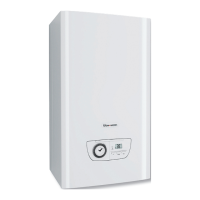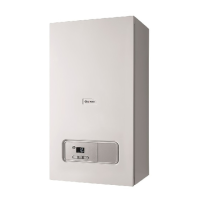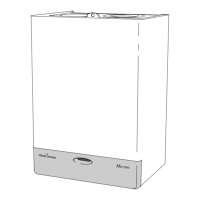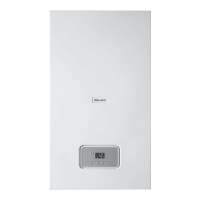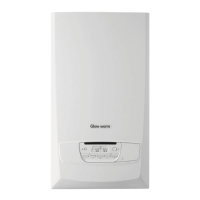15
5 Domestic Hot Water System
General - All domestic hot water circuits, connections, fittings
must be in accordance with the relevant standards and water
supply regulations.
For GB: Guidance G17 to G24 and recommendation R17 to
R24 of the Water Regulations Guide.
For IE: The current edition of I.S.813 “Domestic Gas
Installations”.
5.1 Water Pressure
The maximum working pressure of the domestic hot water
circuit is 10 bar. If the cold water supply pressure exceeds
this, then a pressure-reducing valve must be fitted in the
supply to the boiler.
6.1 Appliance Pack
IMPORTANT: With regards to the Health and Safety Manual
Handling requirements, two persons shall be required to lift
the appliance, refer to section 16 Manual Handling.
Please check the contents of packs as shown in diagram 6.1.
NOTE: The packs are located in the top polystyrene packing.
The wall hanging bracket is located at the rear of the boiler,
slide upwards to remove.
6.2 Wall Template
Take the wall template from the document pack located within
the top polystyrene packing and place in the desired position
on a flat wall, giving due consideration to the required boiler
clearances, see section 2, and the flue you are fitting.
6.3 Flue Hole Cutting
External access flue installation can use a 105mm diameter
core drill.
Internal access only flue installation will need a 125mm diam
-
eter core drill.
If flue extension pipes are to be used then a core drill size
of 125mm is required. This will allow the extension pieces to
slope at 44mm/metre (2.5°) towards the boiler.
5.2 ‘Hard’ Water Areas
The temperatures within the heat exchanger are limited by
the boiler control system to minimise scale formation within
the hot water pipework. However, in areas where the water is
‘hard’ (i.e. more than 200mg/litre), it is recommended that the
hot water setting is reduced and that a scale reducer is fitted.
Refer to the manufacturer’s instructions or consult the local
water company for additional advice.
5.3 Domestic Water Flow Rate
The water flow rate is restricted to a maximum 9.4 l/min for
24cx and 11.7 l/min for 30cx, by a restrictor factory fitted
within the boiler.
6 Installation Preparation
Top horizontal flue - (standard and
telescopic)
The standard horizontal flue is designed with an internal fall of
44mm/metre (2.5°) towards the boiler for disposal of con-
densate therefore the hole can be drilled horizontally. If the
standard flue length alone is being used then the flue hole of
diameter 105mm can be cut in the position marked on the wall
template.
For standard side flues the horizontal flue centre line on the
wall template should be extended to the side wall, and the
vertical centre of the flue hole marked at 176mm from the
back wall.
For extended side flues, the flue hole centre should be
determined by extending the dashed inclined line on the
template to the side wall. This dashed line is drawn at 44mm/
metre (2.5°) rise from the boiler. Where this line reaches the
side wall, a horizontal line should be marked. The vertical
centre line of the flue should then be marked at 176mm from
the back wall.
To allow for the flue passing through the wall at this angle
a 125mm hole should be drilled irrespective of internal or
external installation.
Remove the wall template whilst drilling the flue hole.
6.4 Rear flue - telescopic
The rear flue is designed with an internal fall of 44mm/metre
towards the boiler for disposal of condensate therefore the
hole can be drilled horizontally. For installations with external
access, a 105mm diameter core drill can be used.

